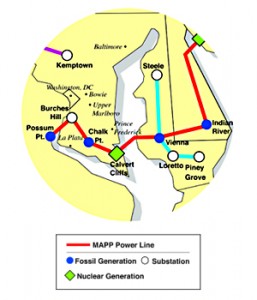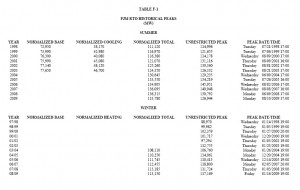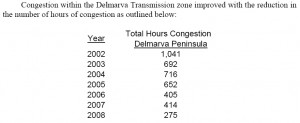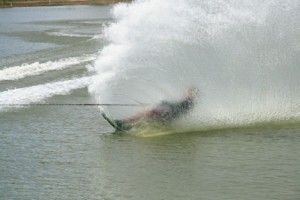That line’s going to fall in my living room…
January 24th, 2010
MID-Atlantic Power Pathway and all of PJM’s “backbone” projects in the news:
She’s worried about a larger line rising in the shadow of her house. If the poles somehow get knocked over, “Where’s that line going to fall? That line’s going to fall in my living room.
That’s Farah Morelli’s question. She’s a regular person who woke up one day with a monstrously large transmission line planned literally in her back yard. That’s usually the most effective way to get someone to learn about transmission. It’s a steep learning curve, and what I’ve found in my work with people in the path of proposed transmission is that once they start looking, they find a disturbing fact: Utilities propose transmission lines not because they’re “needed” but that they’re wanted, wanted to increase their ability to transmit and SELL cheap power in areas where it’s higher cost, and make a bundle in the process. It’s not that people don’t have electricity (and high price is the best instigator of conservation), but it’s that people want more and want it cheaper and the utilities which make $$$ from that equation want to make it happen.
HERE’S THE REALITY — The PJM 2010 Load Forecast Report and the Monitoring Analytics “PJM 3Q State of the Market” report show that this market decline isn’t anything new and that it’s not going away anytime soon. The PJM market peaked in 2006:
Today’s News Journal article is a start at pulling it all together, taking a look at the bigger picture, and that bigger picture is what these transmission lines are all about. Three lines were proposed together, the Potomac Allegheny Transmission Highline (PATH), the Mid-Atlantic Power Pathway (MAPP) and the Susquehanna-Roseland line. These aren’t just transmission lines, they’re BIG HONKIN’ ELECTRICAL AUTOBAHNS, quad (or now maybe tri?) bundled 500kV lines. Like WOW. HUGE!
Here’s today’s article:
Lower energy projections put brakes on power lines
PEPCO wants to suspend MAPP proceedings
January 8th, 2010
And just now, hot off the press… er… inbox, is notice that PEPCO has asked that the Mid-Atlantic Power Pathway, MAPP, be suspended:
PEPCO letter 1.8.09 to suspend MAPP, includes 1.8.09 letter from PJM’s Herling
They’re saying it’s because MAPP is reliant on PATH in the modeling, but they already withdrew the Indian River to Salem leg and delayed the rest due to LACK OF NEED, and now… well, we know it’s not needed. So whatever, I just wish they’d be honest about it.
Again, remember that all three of these, PATH, MAPP, and Susquehanna-Roseland were promoted based on the 2007 RTEP, which was based on those inflated peak figures from 2006!
Here’s the sensitivity analysis from PATH that is applicable to other projects:
Transmission falling like dominos in a hurricane… I love it when this happens!
Baltimore: Rally on Tuesday — say NO to transmission for coal!
November 29th, 2009
It’s so good to be home … for a second or so, that is, before the CapX 2020 Brookings public and evidentiary hearings start. For more on that, go to NoCapX 2020!
PJM’s Mid-Atlantic Power Pathway is in the news again… or is it PEPCO… or is it Delmarva Power… yes, another stupid transmission idea comin’ down the pike… it’s time to say NO! to transmission for coal!
Join the “No New Coal” brigade at the rally:
Baltimore’s Preston Gardens Park
Don’t get confused by this map of MAPP — they’re now admitting that the part from Indian River to Salem “isn’t needed” and it’s only a matter of time before they figure out that a 500kV line to nowhere isn’t needed either.

From The Diamondback, the University of Maryland’s paper – YES! maybe there’s hope, maybe they’ll do a better job than we have:
MAPP and PATH: Time to draw the line
Are people starting to get it? Here’s another from the Diamondback:
Guest column: Toppling King Coal
Krishna Amin is a junior biochemistry major. She can be reached at krish121 at umd dot edu.
Sussex County ponders Power Pathway
November 3rd, 2009
Sussex County has held off on taking a formal stand on Delmarva Power’s Mid-Atlantic Power Pathway, or MAPP, but Delmarva is pushing, so now’s the time to call them with a simple message:
No, don’t encourage and facilitate coal!
Say NO! to Delmarva Power’s Mid-Atlantic Power Path transmission proposal!
Delmarva Power is going around drumming up support for its Mid-Atlantic Power Pathway, or MAPP. They approached Sussex County to support the line (what do we know about that? Not much. Perhaps a FOIA to see what they’ve been doing is in order?) and because there’s a zoning matter before the County, they held off..
Delaware Electric Coop would like to use the MAPP line to bring in electricity from a new Old Dominion coal plant in Virginia. Oh… great idea… I’ve posted about this before:
Here’s Alan’s Green Delaware Alert and handout for DEC’s last annual meeting:
Building a coal plant is a really bad idea, and building transmission for coal is a really bad idea plus… two wrongs do not make a right.
Call all the County Council, thank them for putting on the brakes, and let them know what you think about Delmarva Power’s transmission for coal:
Michael H. Vincent (302) 629-2396
Samuel R. Wilson (302) 856-2972
Joan R. Deaver (302) 645-6657
George B. Cole (302) 539-1611
Vance C. Phillips (302) 542-1501
Here’s a report from the Cape Gazette:
Sussex County council delays support of transmission line
Pathway could pump $260 million in county’s economy
Moore responded with an emphatic yes.
He said anticipated savings are about 60 cents per month in charges related to congestion.
So another utility toady thinks I’ve got my head implanted…
October 4th, 2009
.
Apparently Jonathan Travers, “Engineer of Knowledge” is another utility toady or self-declared energy wonk, and thinks I’ve got my head implanted regarding my comments about the MAPP line and about PSE&G’s dissing Midwest transmission. EH? I’d say my Google Analyics stats say otherwise. And then there’s the little energy birdie who admitted the other day that Legalectric is one of his first stops in the morning!
Who is Jonathan Travers? Haven’t a clue, his reputation does not exceed him! Google’s got very little to say. Hmmmmmmm… There is a “Travers” on the Dorchester County Council, Ricky Travers. This “Jonathan Travers,” he’s got a blog, Jonathan Travers Chronicles, with only a handful of postings that are focused on blasting opposition to the Mid-Atlantic Power Pathway (MAPP) transmission line, i.e., Dorchester County’s Dorchester Citizens for Safe Energy and Eastern Shore Land Conservancy, who are having some success in fighting the MAPP line, and though Travers’ blog’s banner states “Debate Through Logical Argumentation Only. Not For Flamers!” the level of discourse he’s posting is not even up to “Horse’s Ass Awards” and such:
Here are his comments about my MAPP post, “MAPP Transmission Line Under the Microscope” a couple weeks ago:
Submitted on 2009/10/04 at 9:18amTo the attention of Legalectric Blog.
You make the statement, “this transmission line is not needed.” Per logical argumentation, you make (sic) no backup facts to support this opening statement. As any English writing course teaches, this is just poor writing skills (sic). As it has been (sic) well documented by “The Public Service Commission” report (sic) released last December (sic) warned that the state could experience rolling blackouts as early as 2011 to helped (sic… really!) people understand the reason for MAPP’s conception. So with just your opening statement, you have negated your argument and quite poorly I might add (how “sic” can it be?).
Overland comments: “backup facts” about transmission line not needed can be found by searching this site for “decreased demand” and “PJM annual report” and PJM Load Capability. Ummmm, Hello, I’m a writing major, and your comment about “poor writing skills” isn’t about writing, it’s about evidence that you want. Don’t worry, it’s there, just look! “Rolling blackouts” is hysteria, blown away by DEC’s annual Energy Plan, showing sharply decreased congestion on the Delmarva peninsula:
You then go on to post the article from the Star Democrat written by Dustin Holt who may have a journalistic degree but by his statements he has no knowledge of electrical engineering. I have spoken with Mr. Holt in the past and within a short amount of conversation, it was quite apparent that he did not even have the basic understanding of what he was writing about. Mr. Holt starts off by referencing statements from Libby Nagel who has self proclaimed herself (sic) president of the Dorchester Citizens for Safe Energy. It is my evaluation that with her lack of electrical engineering knowledge, Ms. Nagel would be better off proclaiming herself President of the Dorchester’s chapter of the Mickey Mouse Club (SIC!). So once again you have quoted a source that does not have adequate credential (sic) to even be speaking on the subject negating your argument again.Overland comments: I posted the article as a good example of on-the-ground activism, where people work to increase awareness of their issue, and Dorchester Citizens for Safe Energy did a great job! They got press coverage, their elected officials showed up, and pro-MAPP people are flailing wildly — that’s a measure of success! Libby IS, not was, the President, and IS self-DESCRIBED President, she was elected President by the organization, it’s “described’ not “proclaimed.” Your “evaluation” is really immaterial. Ms. Nagel has all the “credential” necessary to speak as an affected community member and President of the primary opposition organization. The article I posted says she’s the “Chairman,” and not “President.” Really!
Let me try to explain it this way. If you run just one transmission route like Ms. Nagel is stating would be (sic) like having one extension cord with a hundred electrical appliances, tools, etc. plugged into it. It will not be long before you have overloaded the circuit causing a short circuit or even causing a fire. It is the diversification that the multiple routes provide so that the electrical load required by the Delmarva Peninsula (sic) is what makes the electrical grid secure and stable.
Overland comments: This is such convoluted and tortured writing that it’s hard to tell where to put the “sic” parentheticals in. WHEW! Anyway, back to “substance.” WTF? I see only one reference to Ms. Nagel in the article, “Dorchester Citizens for Safe Energy Chairman Libby Nagel said the power line would require about a 200-foot right-of-way.” Nowhere in this article is Nagel advocating for “just one transmission route,” and I don’t think Nagle advocates for ANY transmission route, she’s stating that a new transmission line is not needed!
I would suggest that your readers can get the correct and accurate arguments with regards to MAPP at my site http://www.jonathantraverschronicles.blogspot.com/
Overland comment: I would suggest that my readers check out the site and comment away!!! Have at it. My readers will be able to easily dissect that site.
Good day,
Jonathan Travers
Oh, he’s not THAT Jon Travers???
OK, now on to his next comment, on the “PSEG’s Izzo disses Midwest Transmission” post :
Submitted on 2009/10/04 at 2:54pmTo the attention of Legalectric Blog.
In your earlier posting you made the statement, “PJM, the private utility transmission promotion entity, has admitted that the Indian River to Salem part of the line is not justified, and have taken it off their wish list.”
Counter Point:
To start off with PJM simply stands for Pennsylvania, New Jersey, and Maryland and the state of Delaware has now (sic?) been included since its conception. PJM is an oversight committee (EH?) made up of knowledgeable people in the industry but they do not tell power utilities to build anything (EH?). It is the utilities (sic) to come up with their own plan to address the problem of the soon (sic) lack of electrical power for their regions. Again your statement you are passing on are (sic) incorrect(sic) negating you (sic) argument.Overland comment: PJM is more than a committee, it’s a formal business organization. PJM IS the utilities, and per PSE&G testimony in the Susquehanna-Roseland case, PJM is telling them to build the line. Now obviously PJM has no authority, but if they press the matter with FERC, FERC could direct the utilities to build it. It’s much more than an “oversight” committee, it’s an organization that is comprised of utilities, and they not only address electric reliability issues, but they control and manipulate the electric market. “Lack of electrical power?” Somebody hasn’t been reading the SEC filings, reserve margins, and annual reports, EARTH TO MARS, there’s a substantial decrease in electrical use and need, we aren’t going to have a power shortage. Project Mountaineer is not a plan of the individual utilities’ making. JCSP is not a plan of individual utilities, CapX is not a plan of individual utilities…
“A little knowledge is a very dangerous thing,” and the writer of this blog has demonstrated their sever (sic) lack of knowledge in this subject by the statements presented.”
Overland comment: Oh, uh-huh…
Now with this posting they are stating their case as if there is only one transmission line that needs to be considered. For those educated in electrical engineering, it is plain that the writer of this blog does not even have the basic understanding of Ohms Law. What MAPP is offering are multiple access points for electrical transmission routes.
Overland comment: Ummmmm, “they?” And who is advocating for transmission? This is the same thing that “Travers” says about Nagel, who said nothing of the sort. This mantra does not fly. Multiple access points? For what generation? Let’s get clear about that…
For anyone else whom (sic) should (sic) like to inform themselves more proficiently on this subject, I suggest you go to http://www.jonathantraverschronicles.blogspot.com/ where this has all been address (sic) before.
Thank you,
Jonathan Travers************************************
Overland comment: Whoever wrote this is clearly not a native speaker/writer nor in any position to critique writing. Content, well, anyone can criticize content, but I’d guess that “Travers” is a retired engineer or a newly imported engineer who has not had experience with the capitalist system and the shift of focus of PJM, MISO, etc., to economic dispatch, a market system, where economic considerations are primary, and where the game in transmission is how to build out as much as possible while shifting cost-allocation elsewhere, for someone else to pay, anyone. Then PJM gets shot down by the 7th Circuit and all their transmission cost apportionment plans are in limbo.




